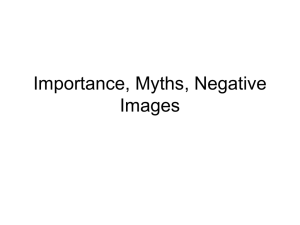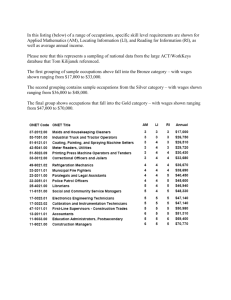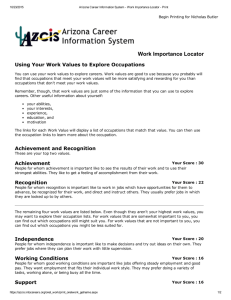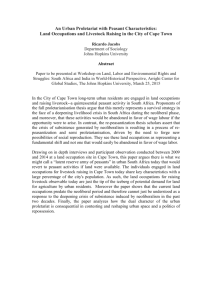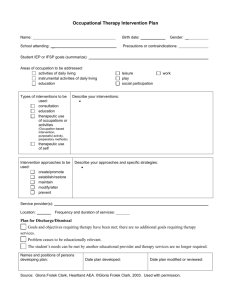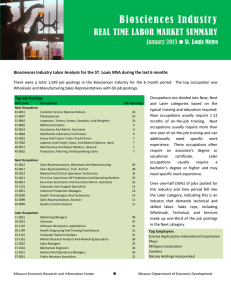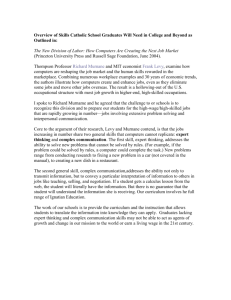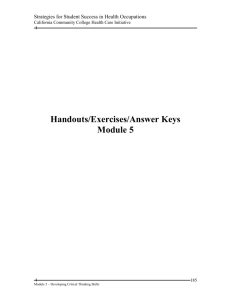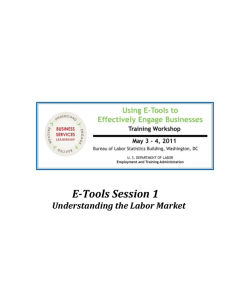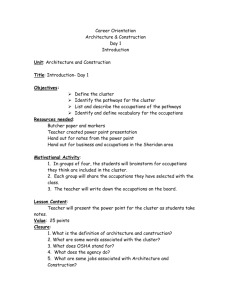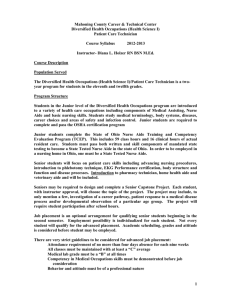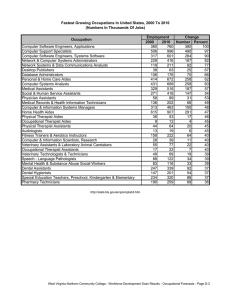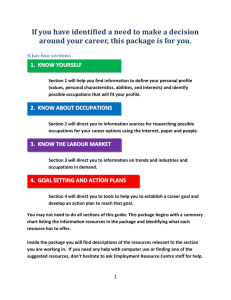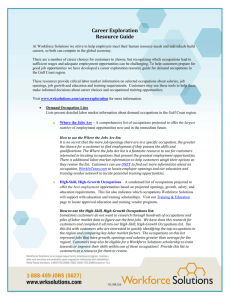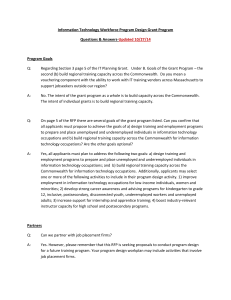Test Bank
advertisement
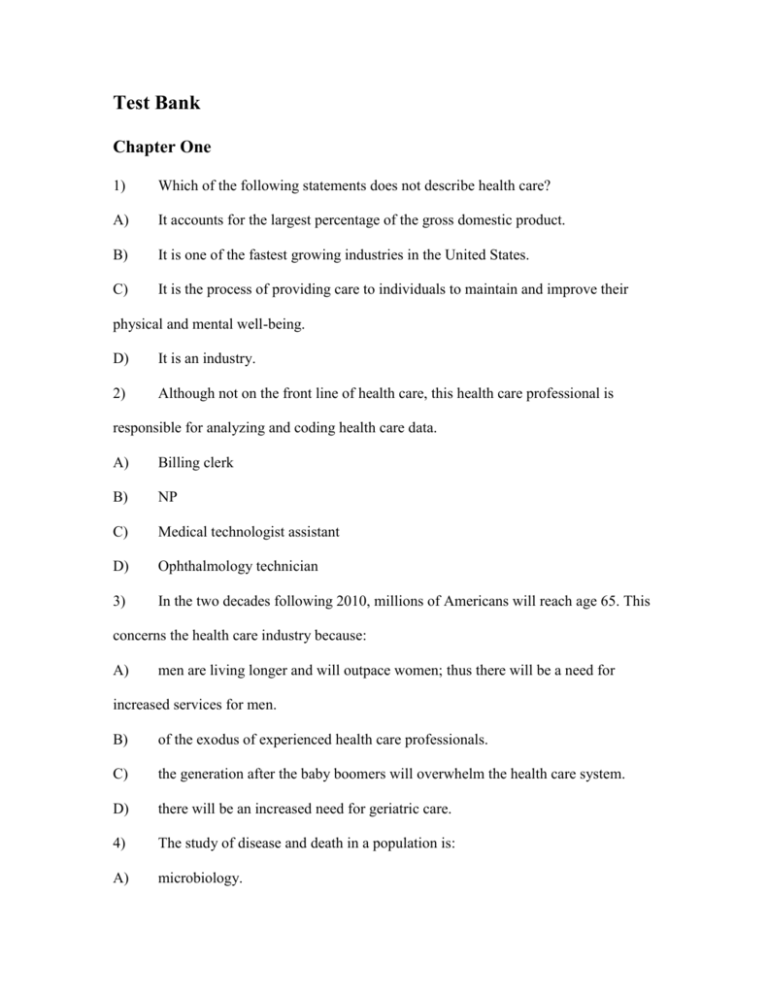
Test Bank Chapter One 1) Which of the following statements does not describe health care? A) It accounts for the largest percentage of the gross domestic product. B) It is one of the fastest growing industries in the United States. C) It is the process of providing care to individuals to maintain and improve their physical and mental well-being. D) It is an industry. 2) Although not on the front line of health care, this health care professional is responsible for analyzing and coding health care data. A) Billing clerk B) NP C) Medical technologist assistant D) Ophthalmology technician 3) In the two decades following 2010, millions of Americans will reach age 65. This concerns the health care industry because: A) men are living longer and will outpace women; thus there will be a need for increased services for men. B) of the exodus of experienced health care professionals. C) the generation after the baby boomers will overwhelm the health care system. D) there will be an increased need for geriatric care. 4) The study of disease and death in a population is: A) microbiology. B) epidemiology. C) anthropology. D) sociology. 5) Two parameters that usually result in an indication of excellent health are: A) genetics and education. B) genetics and income. C) education and income. D) profession and income. 6) All of the following are types of health care facilities except: A) physicians’ office. B) HMO. C) long-term-care facility. D) hospital. 7) Select the least likely employment location for health care professionals: A) Hospitals B) Insurance companies C) Physicians’ offices D) Long-term-care facilities 8) The professional and related occupational category of health care occupations would include: A) medical secretaries. B) registered nurses. C) medical assistants. D) health care managers. 9) The service occupational category of health care occupations would include: A) medical assistants. B) registered nurses. C) medical secretaries. D) health care managers. 10) The office and administrative support occupational category of health care occupations would include: A) medical secretaries. B) medical assistants. C) health care managers. D) registered nurses. 11) Health care employment continues to grow for all of the following reasons except: A) interest in managing cost. B) advances in medical technology. C) aging population. D) inability to automate many functions. 12) Health care policy addresses all of the following issues except: A) cultural. B) access. C) costs. D) quality. 13) The medical model includes all of the following except: A) illness and disease require treatment. B) focus is diagnosis. C) focus is on disease prevention. D) focus is on treatment. 14) The Centers for Disease Control and Prevention: A) survey Americans about their health. B) collect health statistics. C) reported in 2009 that over 65% of respondents rated their health as “very good” or “excellent.” D) monitor hospital compliance with HIPAA. 15) The ability to stay in business for a health care facility is based on the facility’s: A) sustainable competitive advantage. B) reimbursement rates. C) business plan. D) business viability. 16) In 2009, the U.S. spent ________ on health expenditures. A) $2.5 billion B) $50 billion C) $2.5 trillion D) $50 trillion 17) Focus areas of Healthy People 2020 and patterns of disease in the population direct research efforts. Research can be directed at all of the following except: A) cure. B) control. C) prevention. D) the study of rural road traffic patterns. 18) All of the following are examples of locations where long-term care could take place except: A) clinics. B) hospitals. C) rehabilitation centers. D) adult day care. 19) The Patient Protection and Affordable Care Act: A) helps increase the number of people who are uninsured. B) allows the market to drive costs up. C) seeks to improve health care delivery performance. D) is surveying Americans about their health care utilization patterns. 20) Managed care can be described by all of the following except: A) manages the patient’s utilization of services. B) manages the price paid for services. C) has the objective of only providing those services that are necessary to contain costs. D) maintains a sustainable noncompetitive advantage. 21) Sustainable competitive advantage is described by all of the following except: A) varies from business to business. B) depends on the objectives the firm is trying to achieve. C) helps a business maintain its position in the marketplace. D) allows the market to drive costs up. 22) All of the following are examples of the role of public health except: A) crosswalks on streets. B) enforcement of seat belt laws. C) prompt processing of insurance claims. D) free immunization clinics. 23) Mental illness: A) is usually a chronic lifetime disease. B) strikes one of every 10 adults. C) is treated 90% of the time. D) treatment is readily available and inexpensive. 24) The three major places of employment for health care workers are: A) hospitals, nursing and residential care facilities, and physician’s offices. B) insurance companies, dental offices, and public health facilities. C) CDC, hospitals, and residential care facilities. D) adult day care, hospitals, and physicians’ offices. 25) All of the following are categories of health occupations except: A) service occupations. B) professional and related occupations. C) management, business, and financial occupations. D) labor union officials. TRUE/FALSE. 26) Competition is a component of a market economy. 27) The patient is at the center of the health care industry. 28) Less than half of health care workers provide direct patient care. 29) The United States has a national health care system. 30) Health care expenditures account for greater than 15% of the GDP. FILL IN THE BLANK. 31) According to the chapter, _______________are not major employers of health care workers. 32) Focus on prevention of disease and the maintenance of well-being describes the ________________ model. 33) Study of the nature, cause, control, and determinants of the frequency of disease, death, and disability in the human population is ______________________. 34) Census data indicates that the United States has increased its ___________ diversity. ESSAY 35) The health care industry will be affected by the aging of the baby boomer generation. Identify at least two health occupations projected to experience the greatest growth. Include your rationale in your response. 36) The Patient Protection and Affordable Care Act will impact many areas of health care. Discuss the implications you anticipate for you, your family, and your fellow classmates, based on the information in this chapter. 37) Many approaches are used to describe health care. List two approaches. Answer Key 1) A 2) A 3) D 4) B 5) C 6) B 7) B 8) B 9) A 10) A 11) D 12) A 13) C 14) D 15) A 16) C 17) D 18) A 19) C 20) D 21) D 22) C 23) A 24) A 25) D 26) True 27) True 28) False 29) False 30) True 31) home health agencies 32) wellness 33) epidemiology 34) ethnic 35) Responses will vary but may include: home health aides medical assistants medical records/health information technicians 36) Responses will vary but may include: insurance mandated for all family members and by all employers cost of care controlled, therefore decreasing personal cost and potential tax burden quality of care improved 37) economic; delivery systems

